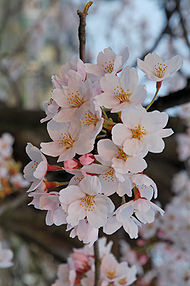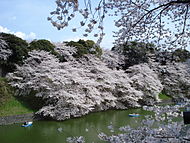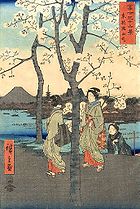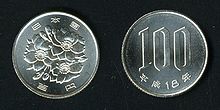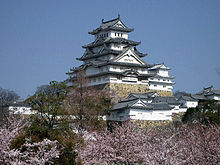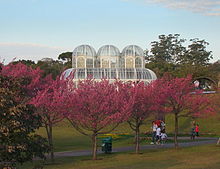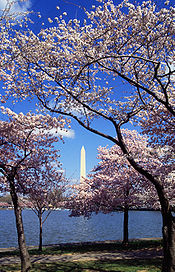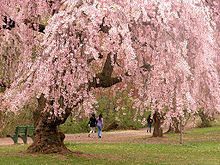- Cherry blossom
-
A cherry blossom is the flower of any of several trees of genus Prunus, particularly the Japanese Cherry, Prunus serrulata, which is sometimes called sakura after the Japanese (桜 or 櫻; さくら).[1][2] Many of the varieties that have been cultivated for ornamental use do not produce fruit. Edible cherries generally come from cultivars of the related species Prunus avium and Prunus cerasus.
Contents
Flower viewing
"Hanami" is the centuries-old practice of picnicking under a blooming sakura or ume tree. The custom is said to have started during the Nara Period (710–794) when it was ume blossoms that people admired in the beginning. But by the Heian Period (794–1185), cherry blossoms came to attract more attention and hanami was synonymous with sakura.[3] From then on, in tanka and haiku, "flowers" meant "sakura." The custom was originally limited to the elite of the Imperial Court, but soon spread to samurai society and, by the Edo period, to the common people as well. Tokugawa Yoshimune planted areas of cherry blossom trees to encourage this. Under the sakura trees, people had lunch and drank sake in cheerful feasts.
Every year the Japanese Meteorological Agency and the public track the sakura zensen (cherry-blossom front) as it moves northward up the archipelago with the approach of warmer weather via nightly forecasts following the weather segment of news programs. The blossoming begins in Okinawa in January and typically reaches Kyoto and Tokyo at the end of March or the beginning of April. It proceeds into areas at the higher altitudes and northward, arriving in Hokkaidō a few weeks later. Japanese pay close attention to these forecasts and turn out in large numbers at parks, shrines, and temples with family and friends to hold flower-viewing parties. Hanami festivals celebrate the beauty of the cherry blossom and for many are a chance to relax and enjoy the beautiful view. The custom of hanami dates back many centuries in Japan: the eighth-century chronicle Nihon Shoki (日本書紀) records hanami festivals being held as early as the third century CE.
Most Japanese schools and public buildings have cherry blossom trees outside of them. Since the fiscal and school year both begin in April, in many parts of Honshū, the first day of work or school coincides with the cherry blossom season.
Symbolism
In Japan cherry blossoms also symbolize clouds due to their nature of blooming en masse, besides being an enduring metaphor for the ephemeral nature of life,[4] an aspect of Japanese cultural tradition that is often associated with Buddhistic influence,[5] and which is embodied in the concept of mono no aware.[6] The association of the cherry blossom with mono no aware dates back to 18th-century scholar Motoori Norinaga.[6] The transience of the blossoms, the extreme beauty and quick death, has often been associated with mortality;[4] for this reason, cherry blossoms are richly symbolic, and have been utilized often in Japanese art, manga, anime, and film, as well as at musical performances for ambient effect. There is at least one popular folk song, originally meant for the shakuhachi (bamboo flute), titled "Sakura", and several pop songs. The flower is also represented on all manner of consumer goods in Japan, including kimono, stationery, and dishware.
The Sakurakai or Cherry Blossom Society was the name chosen by young officers within the Imperial Japanese Army in September 1930 for their secret society established with the goal of reorganizing the state along totalitarian militaristic lines, via a military coup d'état if necessary.[7]
During World War II, the cherry blossom was used to motivate the Japanese people, to stoke nationalism and militarism among the populace.[8] Even prior to the war, they were used in propaganda to inspire "Japanese spirit," as in the "Song of Young Japan," exulting in "warriors" who were "ready like the myriad cherry blossoms to scatter."[9] In 1932, Akiko Yosano's poetry urged Japanese soldiers to endure sufferings in China and compared the dead soldiers to cherry blossoms.[10] Arguments that the plans for the Battle of Leyte Gulf, involving all Japanese ships, would expose Japan to serious danger if they failed, were countered with the plea that the Navy be permitted to "bloom as flowers of death."[11] The last message of the forces on Peleliu was "Sakura, Sakura" — cherry blossoms.[12] Japanese pilots would paint them on the sides of their planes before embarking on a suicide mission, or even take branches of the trees with them on their missions.[8] A cherry blossom painted on the side of the bomber symbolized the intensity and ephemerality of life;[13] in this way, the aesthetic association was altered such that falling cherry petals came to represent the sacrifice of youth in suicide missions to honor the emperor.[8][14] The first kamikaze unit had a subunit called Yamazakura or wild cherry blossom.[14] The government even encouraged the people to believe that the souls of downed warriors were reincarnated in the blossoms.[8]
In its colonial enterprises, imperial Japan often planted cherry trees as a means of "claiming occupied territory as Japanese space".[8]
Varieties and blooming
The most popular variety of cherry blossom in Japan is the Somei Yoshino. Its flowers are nearly pure white, tinged with the palest pink, especially near the stem. They bloom and usually fall within a week, before the leaves come out. Therefore, the trees look nearly white from top to bottom. The variety takes its name from the village of Somei (now part of Toshima in Tokyo). It was developed in the mid- to late-19th century at the end of the Edo period and the beginning of the Meiji period. The Somei Yoshino is so widely associated with cherry blossoms that jidaigeki and other works of fiction often depict the variety in the Edo period or earlier; such depictions are anachronisms.
Winter sakura (fuyuzakura/Prunus subhirtella autumnalis) begins to bloom in the fall and continues blooming sporadically throughout the winter. It is said to be a cross between Tokyo Higan cherry (edohiganzakura/P. incisa) and Mamezakura/P. pendula.[15]
Other categories include yamazakura, yaezakura, and shidarezakura. The yaezakura have large flowers, thick with rich pink petals. The shidarezakura, or weeping cherry, has branches that fall like those of a weeping willow, bearing cascades of pink flowers.
Cherry blossoms in other countries
Australia
 Panoramic view from the Symbolic Mountain at the Japanese Gardens. The view takes in the gardens and the plains of the Cowra district across to the nearby mountains.
Panoramic view from the Symbolic Mountain at the Japanese Gardens. The view takes in the gardens and the plains of the Cowra district across to the nearby mountains.
During World War II, a prisoner of war (POW) camp near the town of Cowra in New South Wales, Australia was the site of one of the largest prison escapes of the war, on 5 August 1944. During the Cowra breakout and subsequent rounding up of POWs, four Australian soldiers and 231 Japanese soldiers died and 108 prisoners were wounded. The Japanese War Cemetery holding the dead from the Breakout was tended to after WWII by members of the Cowra RSL and ceded to Japan in 1963. In 1971 the Cowra Tourism Development decided to celebrate this link to Japan, and proposed a Japanese Garden for the town. The Japanese government agreed to support this development as a sign of thanks for the respectful treatment of their war dead; the development also received funding from the Australian government and private entities.
The garden was designed by Ken Nakajima (1914–2000), a world-renowned designer of Japanese gardens at the time. The first stage was opened in 1979, with a second stage opened in 1986.
The gardens were designed in the style of the Edo period and are a kaiyū-shiki or strolling garden. They are designed to show all of the landscape types of Japan. At five hectares (12 acres), the Cowra Japanese Garden is the largest Japanese garden in the Southern Hemisphere. An annual Sakura Matsuri (cherry blossom festival) is a major event in Cowra's tourism calendar and is held in the gardens during September.
Brazil
With the Japanese diaspora to Brazil, many immigrants brought seedlings of cherry trees. In the Parana State (in southern Brazil), many cities received many of these immigrants, who planted the trees, as in Apucarana,[16] Maringá, Cascavel[17] and especially in the capital city of Curitiba.[18]
In the capital city of Parana, the first seedlings were taken by Japanese immigrants in the first half of the 20th century, but began to be planted in large quantities from the 1990s, with the opening of the Botanical Garden of Curitiba.[18] Now the seedlings are produced by the city and used in afforestation[19] of streets and squares - as in the Japanese Square, where have more than 30 cherry trees around the square sent by the Japanese Empire to Curitiba.[20]
Canada
Vancouver, BC is famous for its thousands of cherry blossom trees lining many streets and in many parks, including Queen Elizabeth Park and Stanley Park. Vancouver holds the annual Vancouver Cherry Blossom Festival every year.[21] High Park in Toronto, Ontario features many Somei-Yoshino cherry trees (the earliest species to bloom and much loved by the Japanese for their fluffy white flowers) that were given to Toronto by Japan in 1959. Through the Sakura Project, the Japanese Embassy donated a further 34 cherry trees to High Park in 2001, plus cherry trees to various other locations like Exhibition Place, McMaster University, York University and the University of Toronto's main and Scarborough campuses.
China
The cherry trees naturally grow in China. However, the two most famous cherry blossom parks in China reflect Japan's brief occupation of parts of China during the first half of the 20th century or the donation from Japan thereafter:
- Longwangtang Cherry Blossom Park in Lushun, Dalian, Liaoning
- Wuhan University in Donghu District, Wuhan, Hubei
Germany
The cherry blossom is a major tourist attraction in Germany's Altes Land orchard region. The largest Hanami in Germany, in Hamburg, with Japanese-style fireworks, organized by the German-Japanese society, draws tens of thousands spectators every spring.
South Korea
Watching of cherry blossom was introduced to Korea during Japanese rule.[22][23] The festivals continued even after the Japanese surrendered in WWII, but have been contentious, and many cherry trees have been destroyed because they were seen as symbols of the occupation.[24] However, there has been considerable confusion about the origin of the cultivated Japanese cherry trees and the differences between them and native Korean trees.[25][26] Certain trees at Seoul's Gyeongbok Palace were cut down to celebrate the fiftieth anniversary of Japanese surrender in World War II.[27] Although Cherry blossoms are already indigenous to Korea, Japan had planted trees on sacred and offensive locations in the Palace. Once the offending trees were cut down the festival continued with the indigenous trees. The cherry blossom festival at Gyeongbok Palace is one of a number of such festivals across Korea and is prominently advertised to tourists.
In 1933, the Japanese botanist Koizumi Genichi reported that the Japanese Sakura (Somei Yoshino) originated on Jeju-do island (Quelpaert).[28] In 1916, Ernest Henry Wilson had thought that "Japanese Sakura (Somei Yoshino)" was a crossbreed of the wild species of Japanese Sakura ("Edo higan" and "Oshima zakura").[29] In 1991, Professor of Tsukuba University Iwasaki Fumio reported that "Japanese Sakura (Somei Yoshino) originated around 1720-1735 by the artificial crossing in Edo (Tokyo)."[30] Recent studies conducted on the comparison of Korean and Japanese cherry blossoms concluded that the two trees can be categorized as distinct species,[31] but the Korean species apparently has not yet been given a scientific name.
Turkey
In 2005, Japanese cherry trees were presented by Japan to the Nezahat Gokyigit Botanical Garden in Istanbul, Turkey. Each tree represents one sailor of Ertugrul Frigate which was the a famous frigate of the Ottoman/Turkish navy. She had encountered a typhoon on the way back from a goodwill visit to Japan in 1890. That heavy weather condition caused her to sink. That disaster resulted with unfortunate loss of 587 Ottoman/Turkish sailors. That unfortunate occurrence is being remembered in every anniversary. The Japanese Cherry Trees represent memory of those passed away and provide remembrance.
United Kingdom
Batsford Arboretum in Gloucestershire holds the national collection of Japanese village cherries, sato-sakura group.[32] Keele University in Staffordshire has one of the UK's largest collections of flowering cherries, with more than 150 varieties.[33]
United States
Japan gave 3,020 cherry blossom trees as a gift to the United States in 1912 to celebrate the nations' then-growing friendship, replacing an earlier gift of 2000 trees which had to be destroyed due to disease in 1910. These trees were planted in Sakura Park in Manhattan and famously line the shore of the Tidal Basin in Washington, D.C. (see West Potomac Park). The gift was renewed with another 3,800 trees in 1965.[34][35] The cherry blossom trees continue to be a popular tourist attraction (and the subject of the annual National Cherry Blossom Festival) when they reach full bloom in early spring. Also, Balboa Park of San Diego has 2,000 cherry blossom trees that blossom in mid to late March. In Los Angeles, over 2,000 trees are located at Lake Balboa in Van Nuys. These trees were donated by an anonymous Japanese benefactor and were planted in 1992. They originated from a single parent tree and were developed to grow in warm climates.[36] Philadelphia is also home to over 2000 flowering Japanese cherry trees, half of which were a gift from the Japanese government in 1926 in honor of the 150th anniversary of American independence, with the other half planted by the Japan America Society of Greater Philadelphia between 1998 and 2007. Philadelphia's cherry blossoms are located within Fairmount Park, and the annual Subaru Cherry Blossom Festival of Greater Philadelphia celebrates the blooming trees. The University of Washington in Seattle also has cherry blossoms in its Quad.
Other US cities have an annual Cherry Blossom Festival (or Sakura Matsuri), including the International Cherry Blossom Festival in Macon, Georgia, which features over 300,000 cherry trees. Belleville, Bloomfield, and Newark, New Jersey celebrate the annual Branch Brook Park Cherry Blossom Festival in April, which attracts thousands of visitors from the local area, Japan, and India. As of April 2009, Branch Brook Park has a cherry tree collection with over 4,000 cherry blossoms in more than fourteen different varieties.[37] Branch Brook Park will soon have more flowering cherry trees than Washington, D.C., thanks to an ongoing replanting program. The Brooklyn Botanic Garden in New York City also has a large, well-attended festival.[38] Portsmouth, New Hampshire, is the site of the peace conference that produced the Treaty of Portsmouth, for which the original Washington, DC cherry trees were given in thanks. Several cherry trees planted on the bank of the tidal pond next to Portsmouth City Hall were the gift of Portsmouth's Japanese sister city of Nichinan—the hometown of Marquis Komura Jutarō, Japan's representative at the conference.[39]
Culinary use
Cherry blossoms and leaves are edible and both are used as food ingredients in Japan:
- The blossoms are pickled in salt and Umezu (Ume vinegar), and is used for coaxing out flavor in Wagashi, (a traditional Japanese confectionery,) or Anpan, (a Japanese sweet bun, most-commonly filled with red bean paste.)
- Salt-pickled blossoms in hot water is called Sakurayu, and is drunk at festive events like weddings in place of Green tea.
- The leaves, mostly from the Ōshima cherry because of the softness, are also pickled in salted water and used for Sakuramochi.
Since the leaves contain Coumarin, however, it is not recommended that one eats them in great quantities, due to its toxicity.
See also
- Cherry
- Kabazaiku: sakura wood craftsmanship
- Kigo: discussion of the role of sakura in Japanese poetry
- Mono no aware
- Ohka: Special Attack Aircraft of World War II
- Prunus
- Subaru Cherry Blossom Festival of Greater Philadelphia
- The Cherry Orchard
References
- ^ "Sakura". Webster's Third New International Dictionary, Unabridged. Merriam-Webster. 2002. http://unabridged.merriam-webster.com/cgi-bin/unabridged?va=sakura. Retrieved 2008-04-02. "JAPANESE FLOWERING CHERRY"
- ^ "Japanese flowering cherry". Webster's Third New International Dictionary, Unabridged. Merriam-Webster. 2002. http://unabridged.merriam-webster.com/cgi-bin/unabridged?book=Third&va=japanese+flowering+cherry. Retrieved 2008-04-02. "any of certain ornamental hybrid cherries developed in Japan chiefly from two species (Prunus serrulata and P. sieboldii) that bear a profusion of white or pink usually double and often fragrant flowers followed by small inedible fruit..."
- ^ Brooklyn Botanic Garden (2006). Mizue Sawano: The Art of the Cherry Tree. Brooklyn Botanic Garden. p. 12. ISBN 1889538256. http://books.google.com/books?id=nHf8lxLOYsUC&pg=PA12&dq=Hanami+nara#v=onepage&q=Hanami%20nara&f=false.
- ^ a b Choy Lee, Khoon. Japan--between Myth and Reality. 1995, page 142.
- ^ Young, John and Nakajima-Okano, Kimiko. Learn Japanese: New College Text. 1985, page 268.
- ^ a b Slaymaker, Douglas. The Body in Postwar Japanese Fiction. 2004, page 122.
- ^ James L. McClain, Japan: A Modern History p 414 ISBN 0-393-04156-5
- ^ a b c d e Ohnuki-Tierney, Emiko. Kamikaze, Cherry Blossoms, and Nationalisms. 2002, page 9-10.
- ^ Piers Brendon, The Dark Valley: A Panorama of the 1930s, p441 ISBN 0-375-40881-9
- ^ James L. McClain, Japan: A Modern History p 427 ISBN 0-393-04156-5
- ^ John Toland, The Rising Sun: The Decline and Fall of the Japanese Empire 1936-1945 p 539 Random House New York 1970
- ^ Meirion and Susie Harries, Soldiers of the Sun: The Rise and Fall of the Imperial Japanese Army p 424 ISBN 0-394-56935-0
- ^ Sakamoto, Kerri: One Hundred Million Hearts. Vintage Book, 2004. ISBN 0-676-97512-7.
- ^ a b Ivan Morris, The Nobility of Failure: Tragic Heroes in the History of Japan, p290 Holt, Rinehart and Winston, 1975
- ^ "Winter-flowering cherry". Retrieved 1 January 2008.
- ^ "Cerejeiras enfeitam cidade no norte do Paraná" (in Portuguese). Jornal Nacional. http://jornalnacional.globo.com/Telejornais/JN/0,,MUL1243172-10406,00-CEREJEIRAS+ENFEITAM+CIDADE+NO+NORTE+DO+PARANA.html. Retrieved 2011-07-15.
- ^ "Cerejeiras enfeitam Cascavel" (in Portuguese). Globo Vídeos. http://video.globo.com/Videos/Player/Noticias/0,,GIM1552862-7823-CEREJEIRAS+ENFEITAM+CASCAVEL,00.html. Retrieved 2011-07-15.
- ^ a b "Temporada das Cerejeiras em Curitiba" (in Portuguese). Diário Urbano. http://diariourbano.com.br/2010/07/06/temporada-cerejeiras-em-curitiba/. Retrieved 2011-07-15.
- ^ "Novo colorido em parques e praças" (in Portuguese). Prefeitura de Curitiba. http://www.curitiba.pr.gov.br/noticias/cerejeiras-dao-novo-colorido-a-parques-e-pracas/23547. Retrieved 2011-07-15.
- ^ "Japan Square". Prefeitura de Curitiba. http://www.curitiba.pr.gov.br/idioma/ingles/pracajapao. Retrieved 2011-07-15.
- ^ "Vancouver Cherry Blossom Festival - VCBF.CA". vcbf.ca. http://www.vcbf.ca/. Retrieved 26 April 2010.
- ^ "몰락한 왕조 궁궐에 핀 사쿠라 일제는 갔어도 벚꽃놀이는 남아". 中央日報. http://article.joins.com/article/article.asp?total_id=3576782. Retrieved 2009-05-11.
- ^ "胸と肩に桜の花を挿して犠牲を誓う18歳の操縦士". 中央日報. http://japanese.joins.com/article/article.php?aid=113981&servcode=100§code=140. Retrieved 2009-05-11.(Japanese)
- ^ Choi Sung-Un (2008). "Biting the cherry: Cherry blossoms and their attendant festivals herald the spring in Korea despite associations with a dark chapter with the country's history". IK-Journal (Investkorea.org). http://www.investkorea.org/InvestKoreaWar/work/journal/content/content_main.jsp?code=4560408. Retrieved 2009-11-30.
- ^ The Cherries of Japan (page 16) (1916).
- ^ Y. Takenaka 1963. The origin of the Yoshino cherry tree. Journal of Heredity 54:207–211 pdf
- ^ Ohnuki-Tierney, Emiko. Kamikaze, Cherry Blossoms, and Nationalisms. 2002, page 122-3.
- ^ Koidzumi, G. 1932. Prunus yedoensis Matsum. is a native of Quelpaert. Acta Phytotaxonomica et Geobotanica, 1:177
- ^ H. Innan, R.Terauchi, NT Miyashita, K Tsunewaki (1995). "DNA fingerprinting study on the intraspecific variation and the origin of Prunus yedoensis (Someiyoshino)". Japanese Journal of Genetics 70 (2): 185–196. doi:10.1266/jjg.70.185. PMID 7605671. http://www.ncbi.nlm.nih.gov/pubmed/7605671. Retrieved 2011-04-19.
- ^ ソメイヨシノとその近縁種の野生状態とソメイヨシノの発生地. 筑波大農林研報 (1991), 3:95-110.
- ^ Roh, M.S., Cheong, E.J., Choi, I-Y and Young, Y.H. (2007). "Characterization of wild Prunus yedoensis analyzed by inter-simple sequence repeat and chloroplast DNA". Scientia Horticulturae 114 (2): 121–128. doi:10.1016/J.scientia+2007.06.005.. http://www.sciencedirect.com/science?_ob=ArticleURL&_udi=B6TC3-4P7FHTX-1&_user=994540&_coverDate=10%2F02%2F2007&_rdoc=1&_fmt=high&_orig=gateway&_origin=gateway&_sort=d&_docanchor=&view=c&_searchStrId=1725580338&_rerunOrigin=google&_acct=C000050024&_version=1&_urlVersion=0&_userid=994540&md5=d453bd60abbb619b5bcfeabbc7957be1&searchtype=a. Retrieved 2011-04-19.
- ^ "Batsford Arboretum". Batsarb.co.uk. http://www.batsarb.co.uk. Retrieved 2009-11-30.
- ^ "Keele University Arboretum flowering cherry collection". keele.ac.uk. http://www.keele.ac.uk/arboretum/trees/cherries/. Retrieved 2011-03-28.
- ^ "nps.gov - Cherry Blossom History". http://www.nps.gov/cherry/cherry-blossom-history.htm. Retrieved 13 January 2009.
- ^ Jefferson, Roland M. and Alan F. Fusonie. (1977). "The Japanese Flowering Cherry Trees of Washington, D.C.: A Living Symbol of Friendship. National Arboretum Contribution No. 4." Washington: USDA, Agricultural Research Service.
- ^ The Big Bloom of Cherry Blossoms at Lake Balboa in Van Nuys
- ^ Essex-countynj.org
- ^ BBG.org
- ^ (http://www.seacoastonline.com/articles/20100415-NEWS-4150431)
External links
- Vancouver Cherry Blossom Festival, Information about the 37,000 cherry trees in Greater Vancouver (Canada), What's in bloom now, Cherry Scout reports and maps, Cultivar identification.
- Subaru Cherry Blossom Festival of Greater Philadelphia, Information about cherry trees and the annual two-week Subaru Cherry Blossom Festival of Greater Philadelphia.
- Cherry Blossom Spots in Japan
- Sakura in Kyoto
- Cherry Blossom Photos
- Cherry Blossoms at Branch Brook Park
- Branch Brook Park cherry blossoms, April 2008
- Copenhagen Sakura Festival
- the place you can see cherry blossoms in Taipei Taiwan (Chinese version)
- Pictures of cherry blossoms in Japan
Categories:- Cherry blossom
- Prunus
- Cherries
- Flora of Japan
- Trees of Japan
- Spring
- Japanese style of gardening
- Garden plants of Asia
- Plants used in bonsai
- Ornamental trees
- Flowers
- National symbols of Japan
Wikimedia Foundation. 2010.

